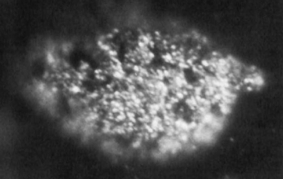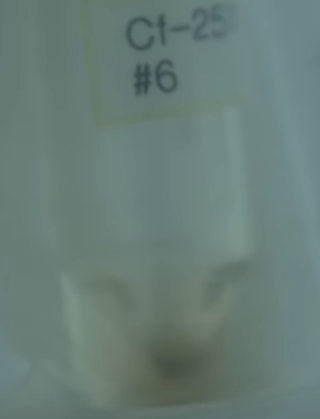Related Research Articles
The actinide or actinoid series encompasses at least the 14 metallic chemical elements in the 5f series, with atomic numbers from 89 to 102, actinium through nobelium. The actinide series derives its name from the first element in the series, actinium. The informal chemical symbol An is used in general discussions of actinide chemistry to refer to any actinide.

Berkelium is a synthetic chemical element; it has symbol Bk and atomic number 97. It is a member of the actinide and transuranium element series. It is named after the city of Berkeley, California, the location of the Lawrence Berkeley National Laboratory where it was discovered in December 1949. Berkelium was the fifth transuranium element discovered after neptunium, plutonium, curium and americium.

Einsteinium is a synthetic chemical element; it has symbol Es and atomic number 99. Einsteinium is a member of the actinide series and it is the seventh transuranium element. It was named in honor of Albert Einstein.

Mendelevium is a synthetic chemical element; it has symbol Md and atomic number 101. A metallic radioactive transuranium element in the actinide series, it is the first element by atomic number that currently cannot be produced in macroscopic quantities by neutron bombardment of lighter elements. It is the third-to-last actinide and the ninth transuranic element. It can only be produced in particle accelerators by bombarding lighter elements with charged particles. Seventeen isotopes are known; the most stable is 258Md with half-life 51 days; however, the shorter-lived 256Md is most commonly used in chemistry because it can be produced on a larger scale.

Ditellurium bromide is the inorganic compound with the formula Te2Br. It is one of the few stable lower bromides of tellurium. Unlike sulfur and selenium, tellurium forms families of polymeric subhalides where the halide/chalcogen ratio is less than 2.

Few compounds of californium have been made and studied. The only californium ion that is stable in aqueous solutions is the californium(III) cation. The other two oxidation states are IV (strong oxidizing agents) and II (strong reducing agents). The element forms a water-soluble chloride, nitrate, perchlorate, and sulfate and is precipitated as a fluoride, oxalate or hydroxide. If problems of availability of the element could be overcome, then CfBr2 and CfI2 would likely be stable.

Bismuth titanate or bismuth titanium oxide is a solid inorganic compound of bismuth, titanium and oxygen with the chemical formula of Bi12TiO20, Bi 4Ti3O12 or Bi2Ti2O7.

3-Penten-2-one is an organic compound with the formula CH3C(O)CH=CHCH3. It exists as (E) and (Z) stereoisomers. The compound is classified as an α,β-unsaturated ketone. It is a colorless volatile liquid with fruity to pungent odor.
Einsteinium compounds are compounds that contain the element einsteinium (Es). These compounds largely have einsteinium in the +3 oxidation state, or in some cases in the +2 and +4 oxidation states. Although einsteinium is relatively stable, with half-lives ranging from 20 days upwards, these compounds have not been studied in great detail.

Holmium(III) iodide is an iodide of holmium, with the chemical formula of HoI3. It is used as a component of metal halide lamps.

Ytterbium(II) fluoride is a binary inorganic compound of ytterbium and fluorine with the chemical formula YbF2.

Berkelium(III) iodide is a binary inorganic compound of berkelium and iodine with the chemical formula BkI3.

Iodine dioxide is a binary inorganic compound of iodine and oxygen with the chemical formula IO
2. This compound is one of many iodine oxides.
Actinium oxyfluoride is an inorganic compound, with the chemical formula AcOF. It is radioactive. It crystallises in a calcium fluoride structure. It can be obtained by reacting actinium fluoride with ammonia and water:
Einsteinium fluoride is a binary inorganic chemical compound of einsteinium and fluorine with the chemical formula EsF3.
Einsteinium tetrafluoride is a binary inorganic chemical compound of einsteinium and fluorine with the chemical formula EsF4. The compound was observed by thermochromatography.

Einsteinium hexafluoride is a binary inorganic chemical compound of einsteinium and fluorine with the chemical formula EsF6. This is a hypothetical compound—its existence has been predicted theoretically, but the compound has yet to be isolated.
Einsteinium(II) chloride is a binary inorganic chemical compound of einsteinium and chlorine with the chemical formula EsCl2.
Einsteinium oxychloride is an inorganic chemical compound of einsteinium, oxygen, and chlorine with the chemical formula EsClO.
Einsteinium(II) iodide is a binary inorganic chemical compound of einsteinium and iodide with the chemical formula EsI2.
References
- ↑ Krebs, Robert E. (30 July 2006). The History and Use of Our Earth's Chemical Elements: A Reference Guide. Bloomsbury Publishing. p. 330. ISBN 978-0-313-02798-7 . Retrieved 26 January 2024.
- ↑ Yaws, Carl L. (6 January 2015). The Yaws Handbook of Physical Properties for Hydrocarbons and Chemicals: Physical Properties for More Than 54,000 Organic and Inorganic Chemical Compounds, Coverage for C1 to C100 Organics and Ac to Zr Inorganics. Gulf Professional Publishing. p. 709. ISBN 978-0-12-801146-1 . Retrieved 26 January 2024.
- ↑ Edelstein, Norman M. (11 September 2013). Actinides in Perspective: Proceedings of the Actinides—1981 Conference, Pacific Grove, California, USA, 10-15 September 1981. Elsevier. p. 322. ISBN 978-1-4831-9051-8 . Retrieved 26 January 2024.